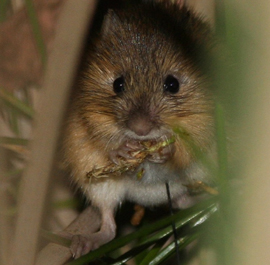|
Designation of Critical Habitat Long Overdue ALBUQUERQUE, N.M.— The U.S. Fish and Wildlife Service today protected 13,973 acres of ‘critical habitat’ for the New Mexico meadow jumping mouse along 169.3 miles of streams, ditches and canals in New Mexico, Colorado, and Arizona. WildEarth Guardians filed suit in 2010 over the Service’s failure to protect the imperiled mouse. The Service then listed the mouse as ‘endangered’ under the Endangered Species Act in June 2014, but failed to simultaneously designate critical habitat. “The critical habitat designation falls dangerously short. The meadow jumping mouse is an indicator of the health of our rivers and streams; we should be protecting every mile of potential mouse habitat,” said Bryan Bird, Wild Places Program Director for WildEarth Guardians. “Just 1% of all our public lands are rivers and streams; they deserve protection.” The U.S. Fish and Wildlife Service finalized protections for the New Mexico meadow jumping mouse on June 10, 2014 as a result of a historic multi-species settlement agreement with Guardians that requires the Service to make listing and critical habitat determinations for 251 candidate species by the end of fiscal year 2016. The final habitat designation comes nearly two years after the listing. “While we are pleased to see some habitat protected, the nearly two year delay is deeply concerning,” said Bird. “Animals teetering on the brink of extinction need timely and inclusive habitat protections.” The meadow jumping mouse lives only within feet of perennial streams with enough lush, dense streamside vegetation to provide food and shelter. The jumping mouse has the longest known hibernation period of any animal: eight to nine months per year. This long hibernation period makes suitable habitat even more critical for the jumping mouse because they must eat enough food in the three to four months they are active to last the full year. Livestock grazing in its streamside habitat threatens the meadow jumping mouse. Over-grazing destroys the streamside riparian and wet meadow habitat on which the meadow jumping mice depend. Native to Colorado, New Mexico and Arizona, meadow jumping mice populations shrunk by at least 76% in the last 15 years and mice are often found only in areas actively protected from grazing. WildEarth Guardians initiated legal proceedings in October 2014 to defend the jumping mouse in New Mexico from threats posed by livestock grazing. The suit challenges the Forest Service’s allowance of livestock grazing that is destroying streamside habitat where the mouse lives, breeds and raises its young. The livestock grazing is violating the Endangered Species Act. “The most important thing we can do to protect the jumping mouse and the ecosystems they call home is to reign in grazing on public lands,” said Bird. Ranchers holding permits to graze on national forest land have also sued the Forest Service in an effort to remove the fences that protect the jumping mouse. A federal court denied their motion for a restraining order and allowed the fences to remain in place, finding that the ranchers’ allegations of harm to their business were exaggerated. The jumping mouse was first recognized as being in need of federal protection in 1985. It was placed on the candidate waiting list for protection in 1991 and again in 2007. Listing species under the Endangered Species Act is a proven effective safety net: more than 99 percent of plants and animals listed persist today. Scientists estimate that 227 species would have gone extinct by 2006 if not for ESA listing. The law is especially important as a bulwark against the current extinction crisis: plants and animals are disappearing at a rate much higher than the natural rate of extinction due to human activities.
photo credit: J.N. Stewart, Flickr/Creative Commons |
|
|
info@wildearthguardians.org | © WildEarth Guardians | Historical Archives | Privacy Policy

